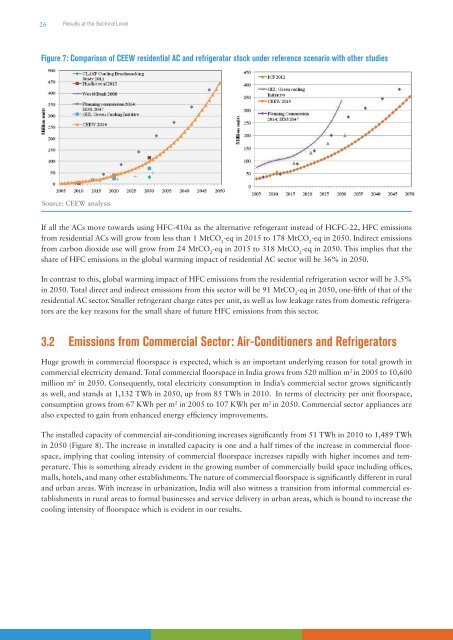Hydrofluorocarbon Emissions-Shakti Sustainable Energy Foundation
One such critically important category of gases is hydrofl uorocarbon (HFC). HFCs are potent greenhouse gases and are expected to contribute signifi cantly to global warming by 2050 (IPCC/TEAP, 2006; Velders et al., 2009; Gschrey et al., 2011; Miller & Kuijpers, 2011; Höglund-Isaksson et al., 2013). Read more information visit: http://shaktifoundation.in/report/indias-long-term-hydrofluorocarbon-hfc-emissions-detailed-cross-sectoral-analysis/
One such critically important category of gases is hydrofl uorocarbon (HFC). HFCs are potent greenhouse gases and are expected to contribute signifi cantly to global warming by 2050 (IPCC/TEAP, 2006; Velders et al., 2009; Gschrey et al., 2011; Miller & Kuijpers, 2011; Höglund-Isaksson et al., 2013). Read more information visit: http://shaktifoundation.in/report/indias-long-term-hydrofluorocarbon-hfc-emissions-detailed-cross-sectoral-analysis/
Create successful ePaper yourself
Turn your PDF publications into a flip-book with our unique Google optimized e-Paper software.
26<br />
Results at the Sectoral Level<br />
Fig ure 7: Comparison of CEEW residential AC and refrigerator stock under reference scenario with other studies<br />
Source: CEEW analysis<br />
If all the ACs move towards using HFC-410a as the alternative refrigerant instead of HCFC-22, HFC emissions<br />
from residential ACs will grow from less than 1 MtCO 2<br />
-eq in 2015 to 178 MtCO 2<br />
-eq in 2050. Indirect emissions<br />
from carbon dioxide use will grow from 24 MtCO 2<br />
-eq in 2015 to 318 MtCO 2<br />
-eq in 2050. This implies that the<br />
share of HFC emissions in the global warming impact of residential AC sector will be 36% in 2050.<br />
In contrast to this, global warming impact of HFC emissions from the residential refrigeration sector will be 3.5%<br />
in 2050. Total direct and indirect emissions from this sector will be 91 MtCO 2<br />
-eq in 2050, one-fifth of that of the<br />
residential AC sector. Smaller refrigerant charge rates per unit, as well as low leakage rates from domestic refrigerators<br />
are the key reasons for the small share of future HFC emissions from this sector.<br />
3.2 <strong>Emissions</strong> from Commercial Sector: Air-Conditioners and Refrigerators<br />
Huge growth in commercial floorspace is expected, which is an important underlying reason for total growth in<br />
commercial electricity demand. Total commercial floorspace in India grows from 520 million m 2 in 2005 to 10,600<br />
million m 2 in 2050. Consequently, total electricity consumption in India’s commercial sector grows significantly<br />
as well, and stands at 1,132 TWh in 2050, up from 85 TWh in 2010. In terms of electricity per unit floorspace,<br />
consumption grows from 67 KWh per m 2 in 2005 to 107 KWh per m 2 in 2050. Commercial sector appliances are<br />
also expected to gain from enhanced energy efficiency improvements.<br />
The installed capacity of commercial air-conditioning increases significantly from 51 TWh in 2010 to 1,489 TWh<br />
in 2050 (Figure 8). The increase in installed capacity is one and a half times of the increase in commercial floorspace,<br />
implying that cooling intensity of commercial floorspace increases rapidly with higher incomes and temperature.<br />
This is something already evident in the growing number of commercially build space including offices,<br />
malls, hotels, and many other establishments. The nature of commercial floorspace is significantly different in rural<br />
and urban areas. With increase in urbanization, India will also witness a transition from informal commercial establishments<br />
in rural areas to formal businesses and service delivery in urban areas, which is bound to increase the<br />
cooling intensity of floorspace which is evident in our results.

















